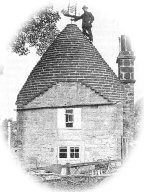Tales from “The Round House” - Curbar
This is a copy of an article published in The Peak Advertiser,
the Peak District's local free newspaper on 1st June 1998,
reproduced by kind permission of its author, Julie Bunting.
Another local tradition asserts that the little building saw use as a pest house although it could hardly have been connected with the Plague which struck Curbar in 1632. Only a short distance from the Round House are the Cundy graves, the burial place of five members of one stricken family from nearby Grislowfields Farm. The Round House has certainly been used as domestic accommodation. If the tale that it housed a whole family seems unlikely, we must remember that one-up, one-down cottages were once commonplace in the Peak, in fact the simplest sort could be put up in a day. The late Clarence Daniel, who was born in 1911, recalled that in his boyhood the building was tenanted by an old sailor named Francis Pelly, who can be seen on our photograph proudly posing with a model ship which he had hoisted onto the roof. Two pennants fluttering from a flagpole behind the chimney must have been his work too. Apparently there was another vessel inside the house, which a girl from the village used to go and reposition every day according to instructions, the reason for which eluded her. Mr. Pelly also removed a few stones from the blank south west wall; Clarence Daniel suggested that the holes were the portholes in his stone ship. For some time between the wars the Round House was occupied by the village linesman, a deaf-mute named Ebenezer Barratt, known as 'Yebby'. He was the last permanent resident and he left behind his initials E.B carved in stone. DISCOVERIES The photograph has most kindly been given to me by a lady [Ed: for the sake of privacy the lady's name is withheld; but for the sake of readability we will call her 'Miss H.'] who has her own fond memories of the Round House, where she stayed regularly for several years from the late 1920s and which she loved so much that she called it 'her' house. She paid the 2s.6d weekly rent out of her own pocket, leaving the only bedroom to her mother while she and a friend camped in an ex-army hut nearby. Jugs of drinking water were fetched from Mrs Beeley, who with her husband owned the Round House, but the rest of their water came from a stream running down the side of the field. A small stone extension to the cottage housed their chemical toilet. The cottage was lit by a single paraffin lamp and there was a small range with an oven in which, just once, 'Miss H.' cooked Yorkshire Pudding for three, a feat she remembers as 'a memorable success'. She wanted very much to live in the Round House permanently and plans were prepared for extension work but sadly the building was condemned as unfit for habitation in 1935. Although 'Miss H.' put her case at an appeal heard at Bakewell this was turned down and her dreams fell through. During her stays at the Round House she was often told by villagers that the building had formerly been a bath house for Cliff College but this story hardly seemed credible until her two dogs discovered the delights of a substantial outdoor water cistern. Built of stone, it was soundly embedded on a gradient above and to one side of the Round House, close to the adjoining moorland. With a high rear wall against the rising ground it measured about 7 feet by 4 feet although there was then not much more than a foot of water inside. ‘Miss H.’ also made an important discovery of her own. For some time she had been intrigued by a map reference to a burial ground, in fact the Cundy graves, but nobody seemed to know its whereabouts. The five stone slabs had been completely overgrown for years. It was 'Miss H.' who found them by gently prodding around the rough ground in the general area shown on the Ordnance Survey map and she still recalls the thrill of exposing the first stone, marked O.C. for Olive Cundy. The rest soon came to light, in turn inscribed with the initials of Thomas, Ada, Nellie and Thomas CUNDY. 'Miss H.' continued to keep the graves clear until she moved to her present home in Grindleford in 1938. Memories of the Round House are clearly very dear to her heart and it has been a delight and privilege to share them with her. Please note that the Round House is privately owned and there is no public access. It can be seen only from a public footpath from which walkers are respectfully asked not to divert. © Julie Bunting References
See also the Old Photograph of the Round House
elsewhere on this site.
|
||||
